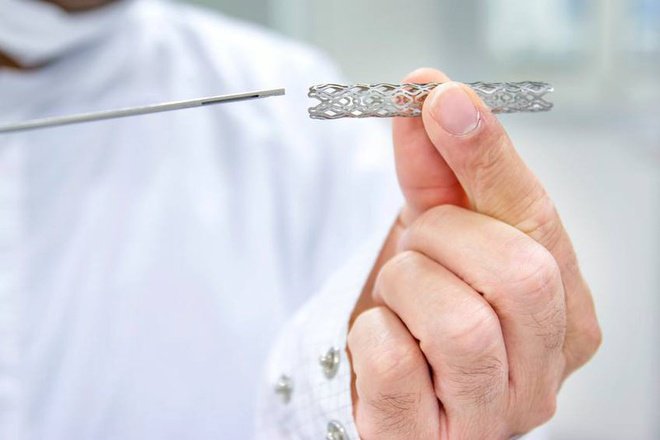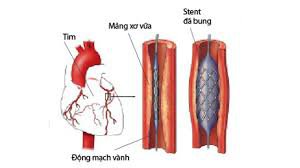Are drug-eluting coronary stents safer than other stents?
This is an automatically translated article.
The article is professionally consulted by MSc Nguyen Van Phong - Internal Medicine and Cardiology Interventionist, Cardiovascular Center - Vinmec Times City International General Hospital. The doctor has more than 15 years of experience in the field of cardiology.
Catheter coronary intervention with drug-eluting coronary stenting technique has become one of the widely used procedures today. According to the results of many studies, drug-eluting stents are safer than other types of stents.
1. What is a drug-eluting coronary stent?
A coronary stent is a metal stent that is placed in the lumen of a coronary artery. The purpose of coronary stenting is to help widen the narrowed coronary artery, keeping it from narrowing.
There are two types of coronary stents: conventional stents and drug-eluting stents. Drug-coated stents are coated with a special layer of medication. This layer of drug will be released gradually into the lumen after stenting and prevents the progression of scar tissue that narrows the lumen.
There are two types of coronary stents: conventional stents and drug-eluting stents. Drug-coated stents are coated with a special layer of medication. This layer of drug will be released gradually into the lumen after stenting and prevents the progression of scar tissue that narrows the lumen.
1.1. Advantages of drug-eluting coronary stents
Drug-coated stents help keep the lumen of the artery smooth and prevent the coronary arteries from narrowing. Compared with conventional stents, drug-eluting stents have a significantly lower rate of coronary restenosis. This technique is considered a major step forward in interventional cardiology and more and more patients are successfully treated with drug-eluting stents.

So với sử dụng stent thông thường, đặt stent phủ thuốc có tỷ lệ tái hẹp mạch vành thấp hơn đáng kể
1.2. Disadvantages of drug-eluting coronary stents
In addition to the advantage of reducing the risk of coronary re-stenosis, drug-eluting stents also have many potential risks. They are:
Risk of blood clots forming in the coronary arteries. Stent thrombosis is an acute complication with a high risk of death. To prevent the risk of blood clots forming, patients need to take antiplatelet drugs such as aspirin or clopidogrel regularly, do not quit on their own; Prolonged use of antiplatelet drugs such as aspirin or clopidogrel increases the risk of bleeding, especially stomach bleeding. Therefore, the patient needs to inform the doctor about his medical condition, and at the same time go to the doctor regularly; Drug-eluting stents limit but not completely prevent coronary re-stenosis. The lumen at the stent site still has a small percentage of narrowing. Therefore, it is necessary to have appropriate and adequate medical treatment to ensure effective treatment for the patient.
Risk of blood clots forming in the coronary arteries. Stent thrombosis is an acute complication with a high risk of death. To prevent the risk of blood clots forming, patients need to take antiplatelet drugs such as aspirin or clopidogrel regularly, do not quit on their own; Prolonged use of antiplatelet drugs such as aspirin or clopidogrel increases the risk of bleeding, especially stomach bleeding. Therefore, the patient needs to inform the doctor about his medical condition, and at the same time go to the doctor regularly; Drug-eluting stents limit but not completely prevent coronary re-stenosis. The lumen at the stent site still has a small percentage of narrowing. Therefore, it is necessary to have appropriate and adequate medical treatment to ensure effective treatment for the patient.
2. Are drug-eluting coronary stents safer than other stents?
A meta-analysis of patients found drug-eluting stents to be safer than other types of stents. Specifically:
Drug-eluting coronary stents reduce the rate of restenosis and revascularization compared with bare metal stents. New generation drug-eluting coronary stents have high safety, effectively reduce the risk of myocardial infarction and stent thrombosis.
Drug-eluting coronary stents reduce the rate of restenosis and revascularization compared with bare metal stents. New generation drug-eluting coronary stents have high safety, effectively reduce the risk of myocardial infarction and stent thrombosis.

Phân tích cho thấy đặt stent phủ thuốc an toàn hơn so với các loại stent khác
3. Indications and safety of drug-eluting stents
3.1 Indications for drug-eluting stents
Angioplasty and drug-eluting coronary stents are indicated in the treatment of coronary artery disease. Specifically, cases:
Patients with stable angina not responding to optimal medical therapy; Patients with stable angina, myocardial ischemia and damage to the coronary artery supplying blood to a large myocardial area; Patients with unstable angina or acute myocardial infarction without ST elevation but stratified at high risk; Patients with acute myocardial infarction with ST elevation; Patients with angina pectoris after coronary artery bypass surgery; The patient after coronary intervention through the catheter has symptoms of restenosis in the stent lumen.
Patients with stable angina not responding to optimal medical therapy; Patients with stable angina, myocardial ischemia and damage to the coronary artery supplying blood to a large myocardial area; Patients with unstable angina or acute myocardial infarction without ST elevation but stratified at high risk; Patients with acute myocardial infarction with ST elevation; Patients with angina pectoris after coronary artery bypass surgery; The patient after coronary intervention through the catheter has symptoms of restenosis in the stent lumen.

Nong và đặt stent mạch vành phủ thuốc được chỉ định trong điều trị bệnh mạch vành
3.2 Safety of drug-eluting stents
Catheter coronary intervention has a small rate of acute embolism and restenosis due to the phenomenon of vessel wall constriction after angioplasty, accompanied by hyperplasia of the coronary intima and remodeling. vascular structure.
Drug-eluting stents reduce the risk of restenosis more than bare metal stents (20 - 30% risk reduction). In addition, the new generation drug-eluting stents also reduce stent thrombosis compared with the first generation, reducing the rate of myocardial infarction and mortality.
However, stent restenosis remains a common challenge in clinical practice. Manifestations of stent restenosis are unstable chest pain and myocardial infarction. Using drug-eluting stents still has a risk of thrombosis in the blood vessels, so patients still have to take anticoagulants and antiplatelet drugs for a long time.
Coronary re-stenosis or stent occlusion can occur if the patient with coronary stent does not follow the doctor's instructions. Therefore, in order to ensure health, after coronary stenting, patients need to continue to use drugs as prescribed, and at the same time pay attention to incision care, maintain appropriate nutrition, and schedule follow-up visits to ensure health. Prevention of possible complications after coronary stenting.
Cardiovascular Center - Vinmec International General Hospital is effectively and safely applying coronary angiography, balloon angioplasty, angioplasty and coronary stenting; meet the needs of timely and effective examination and treatment of acute diseases such as acute myocardial infarction, cardiogenic shock, bradyarrhythmias requiring emergency medical equipment.
The entire procedure of examination and treatment, coronary intervention at Vinmec is carried out by a team of qualified, experienced and well-trained medical doctors, so it brings good treatment results, limited Reduce the risk of restenosis after coronary stenting. Moreover, at Vinmec, all instruments in the intervention procedure, consumables are used once, not reused to ensure the safest for the patient.
Drug-eluting stents reduce the risk of restenosis more than bare metal stents (20 - 30% risk reduction). In addition, the new generation drug-eluting stents also reduce stent thrombosis compared with the first generation, reducing the rate of myocardial infarction and mortality.
However, stent restenosis remains a common challenge in clinical practice. Manifestations of stent restenosis are unstable chest pain and myocardial infarction. Using drug-eluting stents still has a risk of thrombosis in the blood vessels, so patients still have to take anticoagulants and antiplatelet drugs for a long time.
Coronary re-stenosis or stent occlusion can occur if the patient with coronary stent does not follow the doctor's instructions. Therefore, in order to ensure health, after coronary stenting, patients need to continue to use drugs as prescribed, and at the same time pay attention to incision care, maintain appropriate nutrition, and schedule follow-up visits to ensure health. Prevention of possible complications after coronary stenting.
Cardiovascular Center - Vinmec International General Hospital is effectively and safely applying coronary angiography, balloon angioplasty, angioplasty and coronary stenting; meet the needs of timely and effective examination and treatment of acute diseases such as acute myocardial infarction, cardiogenic shock, bradyarrhythmias requiring emergency medical equipment.
The entire procedure of examination and treatment, coronary intervention at Vinmec is carried out by a team of qualified, experienced and well-trained medical doctors, so it brings good treatment results, limited Reduce the risk of restenosis after coronary stenting. Moreover, at Vinmec, all instruments in the intervention procedure, consumables are used once, not reused to ensure the safest for the patient.
Please dial HOTLINE for more information or register for an appointment HERE. Download MyVinmec app to make appointments faster and to manage your bookings easily.
This article is written for readers from Sài Gòn, Hà Nội, Hồ Chí Minh, Phú Quốc, Nha Trang, Hạ Long, Hải Phòng, Đà Nẵng.





